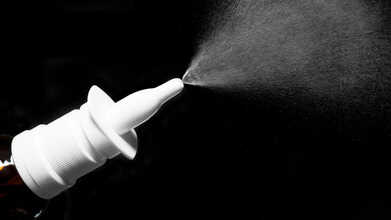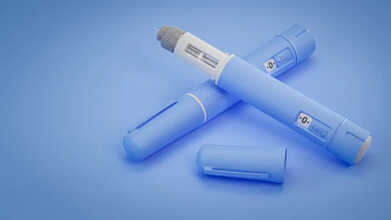- Health Conditions A-Z
- Health & Wellness
- Nutrition
- Fitness
- Health News
- Ayurveda
- Videos
- Medicine A-Z
- Parenting
FDA Recalls Walgreens Nasal Spray Bottles Over Contamination Risk: What You Need To Know

Credits: Canva
Medical Products Laboratories, a Philadelphia company that manufactures medical supplies, has pulled more than 41,000 bottles of Walgreens-branded nasal spray from the market after concerns that some units may contain bacteria that could pose problems for people with fragile immune systems or existing breathing issues.
The product involved is Walgreens Saline Nasal Spray with xylitol, which the U.S. Food and Drug Administration (FDA) says may be contaminated. In total, 41,328 bottles were shipped across the country and could contain pseudomonas lactis, a bacterium that naturally occurs in places such as soil and water, as noted by the Centers for Disease Control and Prevention (CDC).
Walgreens Nasal Spray Recalled: What Bacteria Is Found?
Pseudomonas lactis can cause illness in people with suppressed immunity or respiratory troubles, according to local officials in southeastern Massachusetts who reported the recall, along with television station KARE 11. WTVT also noted that the bacteria may pose added concerns for pregnant people. A 2022 study on antibiotic resistance found the same bacterium in chicken waste.
Which Walgreens Nasal Spray Lots Are Recalled?
The recall affects more than 41,000 bottles of Walgreens saline nasal spray with xylitol because of possible contamination with pseudomonas lactis, which may be risky for people who have compromised immune systems or lung conditions.
The lots included in the recall are Lot #71409, which expires on Feb. 28, 2027, and Lot #71861, which expires on Aug. 31, 2027. Walgreens told USA Today that anyone who bought these products should stop using them at once and bring them back to any Walgreens store for a complete refund.
What FDA Recall Classification Applies Here?
Based on the details available, this situation falls under a Class II recall, which the FDA uses when a product may lead to temporary or reversible health problems, and the chance of more serious harm is considered low. Similar recalls, such as the recent action involving NuNaturals sweeteners, have received the same level of risk designation from the agency.
A Class II recall signals that there is a meaningful health concern, though it is not expected to result in severe injury or death. This matches the structure of the D-0179-2026 classification and reflects how the FDA organizes consumer product recalls. A Walgreens spokesperson told FOX Business that the company’s supplier began the voluntary recall “out of an abundance of caution” and added that customer safety remains a priority.
What To Do With The Recalled Product?
Anyone who has one of the affected bottles should stop using it right away. Walgreens has not posted specific instructions on its website, but the general guidance is to discard the product or return it to the store where it was purchased.
Ozempic 2.0: Could This GLP-1 Pill Be The Most Transformative Weight Loss Solution Yet?

Credits: Istock
Ozempic 2.0: The arrival of Ozempic and similar GLP-1 drugs has already reshaped medicine and consumer behaviour in ways few anticipated. Millions of people have achieved weight loss at levels previously unseen, grocery companies are redesigning products with these users in mind, and insurers are studying how these drugs could influence long-term health and chronic disease. But as significant as this shift has been, the next wave of treatments may transform the field even further, according to the Washington Post.
What Is Ozempic 2.0?
A new generation of GLP-1 therapies is expected in the coming months, including daily pills, more potent injectables, and combination drugs that target multiple hormonal pathways. These options promise easier use, wider metabolic benefits, and in some cases results beyond what current medications offer. Experts caution that these drugs are still under review by regulators, yet anticipation is already high.
Also Read: Why Do People See A Tunnel Of Light During Near-Death Experiences?
Ozempic 2.0: Pills Could Make GLP-1 Medications Accessible
The first daily weight-loss pills may be approved as early as 2026. Novo Nordisk and Eli Lilly have developed oral versions of their popular drugs, providing an option for those who hesitate to self-inject or cannot afford refrigerated pens. Pills are also easier to distribute and could come with lower costs, potentially broadening access in regions where injectable GLP-1s remain expensive.
As per The Washington Post, early clinical trials show oral pills generally result in slightly less weight loss than injections. Participants typically shed around 11–14 percent of body weight over a year, compared with 15–20 percent for the most powerful injectables. Yet researchers believe that convenience, affordability, and broader insurance coverage could make daily pills a turning point for patients and the market alike.
Ozempic 2.0: Stronger Injectables May Make Weight Loss More Easy
Pharma companies are also working on injectables that stimulate multiple appetite-related hormones. Current GLP-1 drugs usually target one or two pathways, while Eli Lilly is testing a compound that acts on three. In mid-stage trials, participants on the highest dose lost more than 24 percent of their body weight in under a year—a result experts say comes close to the effectiveness of bariatric surgery.
Also Read: How Post Malone Lost 55lbs Just By Cutting Soda And Ditching Junk
As per The Washington Post, researchers note that outcomes may vary when larger and longer trials are completed. Regulators will need to assess safety carefully, especially regarding rapid weight loss or changes in muscle mass. Even so, specialists expect that patients with severe obesity may rely on these stronger options when they become available.
Ozempic 2.0: Molecules To Reduce Side Effects
Nausea, digestive discomfort, and lean muscle loss remain common reasons patients stop current GLP-1 drugs. In response, companies are testing combinations aimed at delivering similar weight loss with fewer side effects. One promising approach pairs semaglutide—the compound behind Ozempic and Wegovy—with amylin. Early data suggests this combination can achieve roughly 20 percent weight loss with potentially less digestive strain.
Other research focuses on adjusting hormonal signals to preserve muscle. Trials combining multiple appetite-regulating pathways show encouraging reductions in fat while maintaining more lean tissue, which experts view as vital for long-term metabolic health.
Ozempic 2.0: Monthly Injections Could Replace Weekly Doses
Beyond pills and more potent weekly injectables, some companies are developing drugs that require only a single injection each month. If successful, these treatments could remove one of the biggest barriers for patients struggling with weekly dosing schedules.
Even as new treatments emerge, today’s GLP-1 drugs are unlikely to vanish. Years of safety data, approvals for reducing cardiovascular risk, and expanded use for conditions like sleep apnea give existing medications an edge that newcomers must match. Competition and shifting pricing structures are already pushing costs down, potentially making current options more attractive unless new alternatives clearly outperform them.
Still, the change underway is unmistakable. With multiple drug classes, delivery methods, and hormonal targets in development, the next five years could redefine medical weight loss, and who has access to it.
'Facing Breathing Issues After Morning Walk' Says CJI Surya Kant As Delhi's Toxic Air Worsens

Credits: iStock, X, Nation Press
Just a day after GRAP-3 restrictions were removed from Delhi, the city's pollution levels worsened. The Commission for Air Quality Management (CAQM) lift the GRAP-3 restrictions on Thursday when Delhi recorded its average AQI at 377 at 4pm. However, by 8pm, the AQI as per the Central Pollution Control Board (CPCB)'s data was recorded at 381 by 8pm. Multiple stations also recorded "severe" range.
However, Delhi, as of 10am on Friday, 28 November, AQI was recorded 409, which is under "hazardous". In fact, as per the CPCB data, several areas like Anand Vihar and Burari Crossing, the AQI crossed 400, under 'severe' category, whereas areas like Mathura Road and Lodhi Road crossed 300, under 'very poor' category.
Also Read: How Post Malone Lost 55lbs Just By Cutting Soda And Ditching Junk
Amid Delhi's continuously worsening AQI, the Chief Justice of India, Surya Kant said that he cannot go out for his morning walk as it is causing him breathing issues. "The only exercise I do is walking. But even that is difficult now. Yesterday I walked for 55 minutes, and till morning I had problems,” the CJI said. Senior advocate Kapil Sibal also said that he has completely stopped going out for morning walks. "To breathe this obnoxious air...at out age..." he remarked. Earlier, Justice PS Narasimha warned lawyers about this "very, very serious" pollution levels and urged them to opt for virtual hearings to avoid health risks. "This pollution will cause permanent damage," he said.
However, CAQM believes that the pollution levels will improve by Friday. "Based on the forecast provided by the IMD and the Indian Institute of Tropical Meteorology, we were told the AQI will worsen marginally on Thursday as wind speeds will drop. However, by Thursday evening and from Friday onwards, winds are forecast to pick up again and so the AQI is not likely to touch 400 and into the severe category,” a CAQM official said.
Though experts do not agree. As per IIT Delhi professor Mukesh Khare, as reported in HT, says that even if AQI is improving, it "is likely to deteriorate again, so the decision to remove GRAP based on marginal improvement was illogical". "There is not much difference between an AQI of 320 and 350. We know conditions in winters are harsh and unpredictable and often unfavorable," he says.
What Can Be Done To Protect Yourself Against Toxic Air Pollution?
Dr Rahul Chawla, a neurologist trained at AIIMS posted a video on his Instagram where he shared 5 ways to protect against Delhi's Air Pollution.
Stay Indoors
Dr Chawla suggested that one should stay indoors as much as possible. "You can open the windows and doors only between 1 and 3pm in the day, when you feel that the sun is bright, so that the house gets proper ventilation," he said.
Why 1pm to 3pm is the only time he suggests to have exposure with air? As per a 2023 study by an air filter brand, Delhi's air pollution peaked at 9AM and gradually improved as the day progressed. On an average, Delhi sees roughly as half as much PM2.5 by 5PM. Similarly, in Kolkata, the pollution peaks at 8am and is lowered by 4PM. This is why the safest time to have any sort of air exposure is in the afternoon. Pollution levels also tend to be slightly lower in the afternoon because it is when the sun is at its peak. This heats the ground and causes warm air to rise and mix with atmosphere. This helps disperse pollutants.
He also advised against cleaning inside the house using a dry cloth, and suggested wet cloth to be in use, so that dust does not rise. "Please do not light up things inside the house like burning dhoop (incense for worship), agarbatti (incense sticks), or anything else that causes excessive smoke,” he said.
Use N95 Mask
“If there are elderly people at home, do not let them go for morning walks or evening walks, and if there are children, do not let them play in the park. Exercise at home. You can go up and down the stairs. You can do yoga. If you have a treadmill or a stationary bike at home, you can exercise with it. You can do weightlifting,” he said. However, he suggested that if going out is absolutely necessary, then one must wear N-95 mask properly before stepping out.
Air Purifier
“If you can afford an air purifier, buy one. But keep in mind that the air purifier you are buying should be appropriate for the size of your room,” the neurologist advised.
Work From Home
The neurologist also suggested that if your company permits it, seek work from home option to reduce your exposure from toxic air.
Leave Delhi
Lastly, he suggested that if people can afford, and their profession allows, they must leave Delhi for a few weeks. “Because this city has become a gas chamber,” he warned.
Note: This article is not a medical advice and the information is derived from the video shared by the doctor. Please seek advice from your doctor before making any changes in your lifestyle.
Amid CDC Anti-Vaxxer Deputy Pick and School Vaccine Law Ruling, Third Unvaccinated Kentucky Infant Dies

Credits: iStock
The nation debate around vaccine has intensified in the US, and this week, it has taken a sharper turn as three separate developments have coincided in the country, all concerned with the administration of vaccines. Amid the controversial appointment of nation's top public health agency - the Centers for Disease Control and Prevention (CDC), and a major court ruling on school vaccine requirement in West Virginia, a third case of unvaccinated infant death is reported from Kentucky. The health officials confirm that the infant died of whooping cough, a vaccine preventable disease, which has reignited the debates around the use of vaccine.
Kentucky Confirms Third Unvaccinated Infant Death
While national debates continue, Kentucky is facing a direct and heartbreaking consequence of falling vaccination rates. Health officials have announced the death of another infant from whooping cough, bringing the total to three deaths in the past 12 months. The first two represented the state’s first pertussis deaths since 2018.
The Kentucky Department for Public Health did not disclose where the most recent death occurred. Officials expressed deep concern about the surge in cases and urged families to stay up to date on recommended vaccines. They stressed that vaccination protects not only individuals but also those who are too young or medically unable to be vaccinated.
As of November 19, Kentucky has recorded 566 pertussis cases this year. Infants under one year old face the highest risk of severe illness and death. The health department confirmed that none of the infants who died had been vaccinated, nor had their mothers received the recommended maternal pertussis shot during pregnancy.
Whooping cough begins with mild cold-like symptoms but can progress within weeks to violent coughing fits that make it hard for babies to breathe. Doctors warn that vaccination in pregnancy and infancy remains the most effective way to protect the youngest children.
A Controversial Choice Inside the CDC
The death of an unvaccinated child happened while anti-vaxxer Ralph Abraham, the former Louisiana surgeon general, was appointed as the new deputy director of the CDC. It has drawn immediate criticism. Abraham is now the second highest-ranking official at the agency, yet he has a long record of questioning mainstream vaccine guidance.
During the pandemic, Abraham openly supported the use of ivermectin, discouraged the birth dose of the hepatitis B vaccine and repeatedly criticized COVID-19 vaccines. While serving as Louisiana’s top health official, he instructed his department to stop promoting mass vaccination and stayed silent for two months during a pertussis outbreak that killed two infants earlier this year.
His appointment has alarmed public health experts, including his predecessor. Nirav Shah, who previously served as the CDC’s deputy director, told The New York Times that Abraham is not the right person for a role that involves leading emergency responses. Shah said that delaying public communication about infant pertussis deaths was unacceptable and called it shameful.
West Virginia Judge Expands Vaccine Exemptions
The debate over vaccine policy was further amplified after a judge in West Virginia ruled that the state must allow religious exemptions to its long-standing school immunization requirements. For decades, West Virginia has maintained one of the highest childhood vaccination rates in the country by permitting only medical exemptions.
Judge Michael E. Froble ruled that the policy violated the state’s religious freedom law, which was enacted two years ago. He said families who sought religious exemptions were being forced to choose between following their beliefs and accessing public education. His ruling now applies to all families who have previously requested religious exemptions.
The decision arrives at a time when measles and other vaccine-preventable illnesses are climbing nationwide. It also follows the appointment of Abraham to the CDC and ongoing remarks from Health Secretary Robert F. Kennedy Jr., who has repeatedly expressed skepticism about vaccine science. Together, these shifts are raising questions about how strongly the country’s health policies will hold in the coming years.
© 2024 Bennett, Coleman & Company Limited

